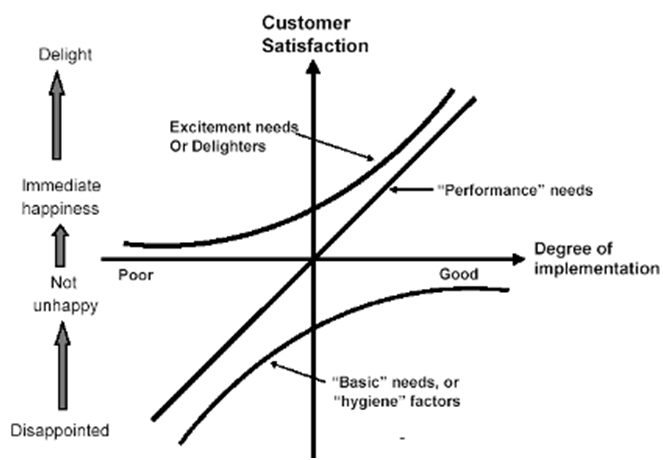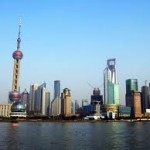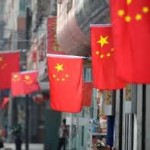
Factors Affecting Customer Satisfaction: case study of London Underground and National Rail Services
There are many factors that affect the level of satisfaction of both product and service customers equally, and some of these factors have been discussed in detail earlier. However, there are also some factors that affect the level of satisfaction of service customers alone, and not necessarily customers satisfaction levels of people buying products. The most common factors proposed by authors that effect the customer satisfaction levels of service customers can be summarized into following points: First, non-verbal behaviour of service provider greatly affects the level of customer satisfaction of service customers (Gabbot, 2000). Due to the fact that most of the services are provided by people, service customers are more sensitive and critical towards behaviour, including nonverbal behaviour of people offering these services. However, this statement is less relevant to services provided by London Underground and National Rail Services, due to the fact that although they operate in service sector, nevertheless, human aspect of their operations that has a direct contact with customers are less intensive compared to many other types of services like teaching and hairdressing. Second, in service sector the quality of service and customer satisfaction level may depend on the competency of a single employee (Barnard, 2000) In cases of London Underground and National Rail Services this statement is especially true which can be illustrated by the role of train operators in cases of trains being held between two stations. London Underground and National Rail Services trains being held between two stations for signal failures and other occasions are not rare occurrences. However, some train operators positively contribute to the level of customer satisfaction by repeatedly apologizing and explaining the reasons of delays, while others damage the customer satisfaction level even more by keeping customers ‘in dark’ in such an unpleasant circumstances. Third, customers’ own involvement…
By John Dudovskiy
Category: Customer Services

Factors Influencing Customer Expectations Factors that influence the level of customer expectations have been specified by Rai (2008) as the following: Firstly, benchmarks specified by service competitors. Competitors’ service benchmark influence customer expectations in a way that the higher the benchmarks, the higher customer expectations will be. Secondly, individual psychology. As it has been discussed above the role of individual differences find greater reflection in the level of customer satisfaction in the service sector compared to the level of customer satisfaction in products. Therefore, most of the service companies strive to adopt individual approach taking into account expectations and characteristics of each individual customer (Barnard, 2002) Thirdly, individual background. As it has been identified that individual psychology plays a great role on the service expectations from that individual; individual background as one of the main determinants of individual psychology also plays an important role in customer service expectations. Fourthly, previous service records of the company. When potential consumers approach a service company they will have their expectations according to various characteristics of the company, including its previous service records. Accordingly consumer expectations will be high in companies with reputable service records, and vice-versa. Issues in Customer Expectations As it has been well established in business world, one of the important conditions of ensuring long-time profitability of the business is meeting or exceeding customer expectations at all times. However, even with the willingness of the company to exceed customer expectations and with relevant skills and capabilities achieving this objective can prove to be challenging due to the following reasons specified by Rai (2008): Firstly, customer expectations may be unrealistic. The issue of customer expectations being unrealistic have been raised by several authors including Miller (1995), James (2004), and Hayes (2008). The common practice for service companies in such a scenario…
By John Dudovskiy
Category: Customer Services

Service Quality Model pioneered by Gronroos (1982) states that customer’s perception of quality, and ultimately customer satisfaction depends on customer’s perception of two dimensions of the service: technical quality and functional quality. Technical quality dimension of the service concentrates on what the customer receives, focusing on the technical outcome of the process. Functional quality, on the other hand, concentrates on how the consumer receives the technical outcome. A service concept is explained by Johnston and Calrk (2008, p.42), as a shared understanding of the service nature provided and received, which should encapsulate information about: – The organizing idea, which is the essence – The experience. – The outcome. Lancaster et al (2002, p. 75) inform that consumer buyer behaviour is influenced by a range of environmental and individual factors. Environmental influencers include cultural, social class, groups/family, situational factors and marketing efforts, and individual influencers include psychological aspects, lifestyle, demographics and economic situation. References Johnson, R & Clark, G, 2008, “Service Operations Management”, third edition, Prentice Hall Lancaster, G, Massingham, L & Ashford, R, 2002, “Essentials of Marketing”, fourth edition, McGraw-Hill
By John Dudovskiy
Category: Customer Services

Kano model of Customer Satisfaction was proposed by Kano et al (1996) and it focuses on product attributes on the basis of how they are perceived by customers and their effect on customer satisfaction. The model distinguishes three types of product attributes that contribute to customer satisfaction in varying degrees: basic attributes, performance or spoken attributes, or surprise or delight attributes. Kano model of customer satisfaction is not only valid for manufacturing businesses; rather it also equally can be applied to the service sector, including London Underground and National Rail Services. The basic or expected attributes for London Underground and National Rail services would be to ensure the commute of their customers from one destination to the other. Customers would be highly disappointed when the basic attributes of their services are not ensured, let alone the extremely low level of their satisfaction level if such a situation were to occur. Performance or spoken attributes of services of London Underground and National Rail Services would be the speed at which customers are taken, to their destination, the level of crowdedness inside the carriages, on platforms and stations in general, the level of customer services customers are offered by staff, and others. The level of performance or spoken attributes of services offered by London Underground and National Rail Services make a huge difference on the customer satisfaction, in a way that the better the performance, the higher customer satisfaction level will be. Surprise and delight attributes, are the ones that are not generally expected by customers, but if they are present they will make a significant contribution on the level of customer satisfaction. However, the absence of surprise and delight attributes would not dissatisfy customers due to the fact that customers would not be expecting them in the first place. For instance,…
By John Dudovskiy
Category: Customer Services

Johnson and Clark (2008) define service concept as a shared understanding of the service nature provided and received. They also state that service concept has to provide information about the essence of the service, service experience, and service outcome. “The terms customer satisfaction and perception of quality are labels we use to summarize a set of observable actions related to the product or service” (Hayes, 2008, p.33) The most comprehensive definition of satisfaction has been offered by Kotler and Keller who define satisfaction as “person’s feeling of pleasure or disappointment which resulted from comparing a product’s perceived performance or outcome against his/ her expectations” (Kotler and Keller, 2006, p.144). “Perception is defined as consumer’s belief, concerning the service received or experienced” (Rai, 2008). Categorisations of Customer Satisfaction and Service Perception Parasuraman et al (1991) divide customer service expectations into two levels: desired and adequate. Desired level of service expectations is a state of service the customer desires to receive, whereas adequate level of customer expectation is the level of service the customer can only “accept” without being too satisfied with it. If desired and adequate levels of service expectations are to be explained in case of London Underground and National Rail Services customers, desired level of customer expectation would be to go from one destination to the other with no crowded train as quick as possible, whereas, adequate level of customer expectation would be just to go to destination even if the train carriage is crowded, and the train is not moving too fast. Walker (1995) offers conceptualised service encounter model that is divided into three disconfirmation stages: First stage is evaluation stage in which peripheral service is offered before the consumption of the core service. Second stage involves intensive anticipation of core service by consumer. Third stage is the final in…
By John Dudovskiy
Category: Customer Services

Contribution of the class to analytical and behavioural skills I have gained huge benefits from learning the module of International Marketing both at personal and professional levels. Professional benefits include the knowledge I have gained regarding the subject and all the related principles, and theories like the impact of globalisation in international marketing, the importance of segmentation, the current global marketing issues, the global marketing environment and its influence to companies, global market entry strategies, components of a global marketing plan etc. Personal benefits I have obtained as results of the module include skills I have gained like increasing the level of my cross-cultural awareness, the ability to critically analyse global issues, improving my communication skills etc. I was familiar with the subject of marketing even before the module through marketing management module I have attended before. However, International Marketing module has equipped me with knowledge and way of thinking that allowed me to approach the issues of marketing I was already familiar with from a global perspective. For example, the analysis of external business environment in marketing management which is done using PESTEL strategic tool, external factors affecting the business were looked at in a specific country level. In international marketing, on the other hand, each individual factor of PESTEL analysis is looked at in the global level, allowing me to see the bigger picture. This is very important taking into account the fact that the forces of globalisation are ever-increasing, the importance of trade border between the various countries are decreasing, and as a result today companies may expect competition for their businesses from any parts of the world. I found the decisions regarding the components of marketing mix to be more challenging in international marketing than these decisions to be taken within company’s home country alone, because increasingly…
By John Dudovskiy
Category: Personal reflection & development

China’s rapid growth last three decades offered big opportunities for foreign companies eager to expand their business and market. Moreover, special privileges and tax incentives provided for these big companies led them heavily invest in China’s market and increased inflow of FDI into country. As a result, today most global companies like General Motors, Siemens, Coca-Cola, Nike and many others are making more aggressive push into China, in some cases moving not only their production centres but their research and development centres too (Barboza, 2010). Also, it is clear that FDI is usually imported to a host country by rather multinational companies than small-medium sized businesses, whose seeking to take advantage of particular benefits, that is to say cheaper work force, cheaper land value, cheaper taxes etc, in order to reduce the production cost and to gain a competitive advantage over rival companies. Therefore, it is important to acknowledge how vital these Multi-National companies (MNC’s) have been to China’s rapid expansion in foreign trade and its export growth as they introduced new and advanced technologies in many sectors and industries, most of which are export oriented, which in turn raised product quality. Furthermore, with creation employment and higher wages, they helped to raise living standards and to improve local infrastructure in rural areas of country. Main determinants of FDI in China There have been numerous factors that resulted in significant proportion of FDI inflows into China. But the most important ones that attracted huge levels of FDI into the country are the following: First of all, since the economic reformation of China in 1979, the country realized that it needs foreign capital in order to improve the economic infrastructure of the country, therefore, it promoted the trade openness that enhanced the levels of FDI. Secondly, due to increasing levels of…

As part of the economical reforms that began in 1978, the Chinese authorities shaped preferential policies to attract foreign investments. As a result, China received a hundreds of billions of dollar in FDI, making it largest developing country to host FDI as recent inflows account for nearly 40 percent of combined flows of FDI to all developing countries (IMF 2000). Though these figures very impressive, however, there are certain problems that Chinese government has to overcome if FDI is needed to sustain country’s continuing record growth rate and further its economic development. The figures published by OECD (2000) shows that distribution of FDI in Chine has been very disproportionate among regions. Between period of 1983 and 1998, eastern region attracted 87.8 percent of FDI whereas the central region took 8.9 percent and western region grabbed only 3.3 percent. The report states that main reason behind this inequality is inappropriate FDI policies taken by the Chinese authority. Creation of special economic zones (SEZs) and preferential regimes for 14 coastal cities resulted in geographically an overwhelming concentration of FDI in the east region. Only after adoption of more broad-based economic reforms and open door policies for FDI in the late 1990s, spreading of FDI inflows into other provinces accelerated. However, Broadman and Sun (1997) argue that FDI’s geographically distribution in China is influenced by many different factors rather than solely government policies. They empirically analysed the geographic determinants of FDI in China and concluded that to a large extent the destination of FDI within China is determined by market size, the extent of infrastructure development, the basic education level among adults, vicinity to import and export markets as well as capital sources and special investment policies. The sectoral of FDI varies from country to country and from year to year. As for…
By John Dudovskiy
Category: Finance

Total inward and outward FDI flows Inward FDI – Since after the economic reformation of China, the country moved towards more market oriented economy, it has received a very large part of international direct investment flows.China has become the second largest host country to FDI in the world afterUnited States, and the largest FDI recipient among the developing countries. In fact, as stated by OECD report (2000), for period of twenty years, actual amount of FDI inflows from 1979 to 1999 totaled to 306 billion US dollar, which is equal to 10 percent of direct investments worldwide and around 30 percent of investment amount for all the developing countries. Furthermore,China consistently continued to receive a large share of direct investments in developing countries in the first decade of 21st century. This argument backed up with figures published by OECD (2005) with the inward FDI into mainland China rising to amount of $55billion in 2004 from $47 billion in 2003. However, there is significant concern among experts in China about possible overheating of the investment cycle as much of this investments accounted toHong Kongbased investors. Outward FDI – While China continues to be largest FDI recipient, it is also gaining importance in world stage as outward investor as well. Many large companies operating in China appear to developing into truly international corporate networks through investments. Moreover, Chinese enterprises are increasingly trying to do “strategic” investments abroad, not least to gain access to raw material. However, the process has been uneven. Figures released by China’s State Administration for Foreign Exchange (OECD Observer, 2005) shows that net outward FDI declined from a peak of $6,9 billion in 2001 to £152,3 million in 2003, then slightly recovered to $1,8 billion in 2004. Nevertheless, OECD figures suggest that these figures may understate the position. …

China’s economic transformation towards more market oriented economy has been one of the most dramatic economic developments of recent decades. Between the period of 1979-2009, China’s growth rate averaged 9% per annum and its integration into the world trading system has been crucial (IMF, 2010). Between the period of 1979 to 2005 its share in world trade has increased from less than 1% to 6, 4%. After three decades of spectacular growth,China even beat Japan to become world’s second largest economy behind the US (Barboza, 2010). Thanks to its open economy, the ration of foreign trade to GDP increased from 12 per cent to 34 per cent (OECD, 2005). According to study of Zhang (2006) and many others, the significant growth in China’s foreign trade in the past two decades has strong relationship with the inflow of FDI as it has been core at the core of China’s foreign trade expansion. Furthermore, this was backed by the OECD report (2000) that FDI has been decisive factor in China’s involvement in the international segmentation of the production process known as globalization. Following the large amount of FDI in manufacturing field, exports and imports as a share of GDP rose from negligible amounts to nearly 25 percent in 2000. The average tariff rate fell from 50 percent in the early 1980s to about 15 percent in 2000, less than half of that India as China exempts so many goods entirely from custom duties. Moreover, a significant share of imported goods are illegally imported, the tariff collection rate as a percent of total value of imports has been much lower. As a result, the tariff revenue as a percent of total imports is only 3 percent in China, compared with 23 percent inIndia. As matter of fact, the net FDI inflows into China…
By John Dudovskiy
Category: Finance
